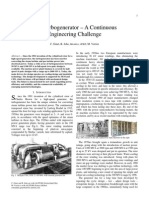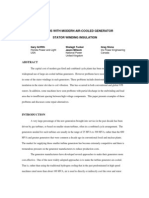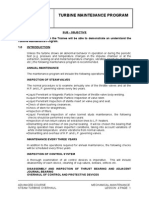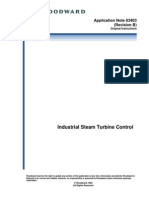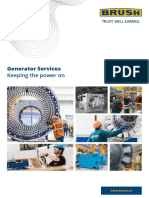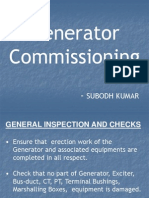2 - Generator Maintenance
2 - Generator Maintenance
Uploaded by
Amba James AsukCopyright:
Available Formats
2 - Generator Maintenance
2 - Generator Maintenance
Uploaded by
Amba James AsukOriginal Title
Copyright
Available Formats
Share this document
Did you find this document useful?
Is this content inappropriate?
Copyright:
Available Formats
2 - Generator Maintenance
2 - Generator Maintenance
Uploaded by
Amba James AsukCopyright:
Available Formats
GENERATORS MAINTENANCE
Typical Generator Maintenance
Generators
System controls
REASONS WHY GENERATORS FAIL
FOREIGN OBJECT DAMAGE Problem: Objects can come from external sources or failure of internal components, they can pick up energy from the spinning rotor and do extensive damage Prevention: Inspect on a regular basis all internal parts that are prone to failure or can be dislodged. Inspection tests can be a combination of visual inspection along with ultrasonic or magnetic particle tests on rotating components
STATOR WINDING VIBRATION
Problem: Primarily a design related problem that affects large (>300Mw) generators which have insufficient end winding bracing to limit the movement of end turns. Prevention: Proper bracing of the end winding is required to limit motion caused by steady state and transient electromagnetic forces.
ROTOR WINDING DISTORTION
Problem: Rotor winding distortion caused by poor end turn blocking support design or by foreshortening of the rotor coils. Foreshortening is caused by thermal forces which compress rotor coils. Prevention: Proper design of rotor coils and bracing to support the coils under axial load is essential. Rotors should be tested for turn to turn shorts at operating speed.
STATOR WINDING VIBRATION
Problem: Primarily a design related problem that affects large (>300Mw) generators which have insufficient end winding bracing to limit the movement of end turns. Prevention: Proper bracing of the end winding is required to limit motion caused by steady state and transient electromagnetic forces.
OVERHEATING
Problem: Overheating of the rotor or stator can lead to insulation failure, shorting of turns and ground faults. Overheating can result from blocked ventilation passages caused by shifting insulation components or slot wedges. Prevention: Inspect on a regular basis to ensure all rotor wedges are "locked" in place preventing migration and thus blocking of cooling passages.
CONTAMINATION
Problem: For air cooled machines, dirt and dust cause tracking which can lead to electrical ground faults. Prevention: Inspect air filterson a regular basis , the filters must be checked and cleaned regularly. Polarization index (PI) tests give a good indication of overall cleanliness of the rotor winding.
ROTOR VIBRATION
Problem: There are many causes, turn-to-turn shorts, rotor coil foreshortening, electrical grounds, mechanical imbalances, overheating, etc. Prevention: Comprehensive vibration measuring is effective combined with a regular maintenance program.
STATOR WEDGE LOOSENESS
Problem: When stator wedges become loose, coils can vibrate causing insulation wear leading to ground faults or turn-to-turn shorts. Prevention: Inspect on a regular basis tightness of wedge blocks.
STATOR CORE DAMAGE
Problem: Stator core looseness can occur over time as pre-tensioned through bolts relax. A loose core results in insulation wear to coils and laminations resulting in hot spots and core-to-coil failures. Prevention: Inspect bolt tightness on a regular basis.
GENERATOR MAINTENANCE
The following tests which should be carried out annually in addition to vendor recommended maintenance.
A) INITIAL GENERATOR TEST
Megger rotor winding Megger exciter armature winding Megger exciter field winding Complete polarization index (pi) on main stator Check bearing insulation
B) INSPECTION ON STATIC EXCITER
Remove exciter end cover Examine condition of diode carrier Examine exciter armature/stator for contamination Examine exciter armature/stator for winding wear Check pmg magnets for contamination
C) ELECTRICAL CONTROL/PROTECTION PANEL
Visually inspect external surfaces of panel Complete insulation resistance checks of panel wiring Check function of all relays Check all fuses Check all lamps Check operation of all switches Check operation of panel heaters Run generator; recalibrate avr Secondary inject all protective relays
E) ROTOR EARTH FAULT PROTECTOR
Carry out static checks to confirm operation of detector Carry out functional check to confirm operation of detector
F) SLIP-RINGS AND BRUSH-GEAR (IF FITTED)
Check all brushes for grade and length Check condition of brush holders/mountings Check that spring tensions are correct Check conditions of slip-rings Check mechanical run-out of slip-rings Check cooler and leakage alarms
You might also like
- Top Five Causes of Switchgear FailureDocument3 pagesTop Five Causes of Switchgear FailureGlenn Adalia Bonita80% (5)
- MATH - P6 - Chapter 9 Practice 2Document12 pagesMATH - P6 - Chapter 9 Practice 2Titin ChayankNo ratings yet
- Vibrational Behaviour of The Turbo Generator Stator End Winding in CaseDocument12 pagesVibrational Behaviour of The Turbo Generator Stator End Winding in Casekoohestani_afshin67% (3)
- Designing TurbogeneratorDocument6 pagesDesigning TurbogeneratorMadhan Gopal100% (2)
- Electric Motor TestingDocument5 pagesElectric Motor Testings_r_manoNo ratings yet
- Gen Insitu InspectionDocument2 pagesGen Insitu Inspectionkamal_khan85No ratings yet
- ARIPPA 2013 Generator Inspection and RepairsDocument34 pagesARIPPA 2013 Generator Inspection and Repairschandu_power1759No ratings yet
- Study of Turbo-Generators.Document37 pagesStudy of Turbo-Generators.Brijesh Kumar100% (7)
- Condition Monitering On Motors and GeneratorsDocument85 pagesCondition Monitering On Motors and GeneratorsPrabhu Koppal100% (1)
- GER4212 GE Generator Rotor Design Ops Issues Refubishment OptionsDocument28 pagesGER4212 GE Generator Rotor Design Ops Issues Refubishment OptionsAli Ghulam100% (1)
- Testing of Turbo Generator: Chapter-1IntroductionDocument4 pagesTesting of Turbo Generator: Chapter-1Introductionemmanuel aka100% (2)
- Diagnostic Tests and Condition Monitoring of Electrical MachinesDocument3 pagesDiagnostic Tests and Condition Monitoring of Electrical Machineslbk50No ratings yet
- Maintenance of TrafoDocument4 pagesMaintenance of TrafoNauval Bangbang Dwi PutraNo ratings yet
- Generator ProtectionDocument5 pagesGenerator ProtectionBala MNo ratings yet
- Welcome To Presentation On Generator Construction by Pawan BhatlaDocument19 pagesWelcome To Presentation On Generator Construction by Pawan BhatlarahulNrana100% (2)
- Problems With Modern Air-Cooled Generator STATOR WINDING INSULATIONDocument8 pagesProblems With Modern Air-Cooled Generator STATOR WINDING INSULATIONBasu Deo Bhomia100% (1)
- Lesson Turbine Mainte0Ance ProgramDocument2 pagesLesson Turbine Mainte0Ance Programmister pogi100% (1)
- Upgrading of Generators To Improve ReliabilityDocument10 pagesUpgrading of Generators To Improve ReliabilityDanielAlejandroRamosQueroNo ratings yet
- Performance Improvement of Combined Cycle Power Plant Based On The Optimization of The Bottom Cycle and Heat RecuperationDocument6 pagesPerformance Improvement of Combined Cycle Power Plant Based On The Optimization of The Bottom Cycle and Heat Recuperationwgxiang100% (5)
- 6b Motor Nameplate Handout.325 PDFDocument19 pages6b Motor Nameplate Handout.325 PDFAntonius Dicky100% (1)
- Life Management and Maintenance For Power Plants Vol. 1Document404 pagesLife Management and Maintenance For Power Plants Vol. 1kp pkNo ratings yet
- 30 Years of EL CID Use May 30 - J SuttonDocument14 pages30 Years of EL CID Use May 30 - J Suttonsarunagarajan7795No ratings yet
- Field Experiences of Gas Turbines Vibrations-A Review and Case StudiesDocument13 pagesField Experiences of Gas Turbines Vibrations-A Review and Case StudiesMohammadreza Galeban100% (1)
- Operating Experience With A Generator End WindingDocument14 pagesOperating Experience With A Generator End WindingutherunixNo ratings yet
- Generator Protection XZCDocument25 pagesGenerator Protection XZCblaagica100% (2)
- Bharat Heavy Electricals Limited: Thermal Power Plant Industrial TrainingDocument20 pagesBharat Heavy Electricals Limited: Thermal Power Plant Industrial TrainingSaurabh SinghNo ratings yet
- Stator End Winding Vibration and Temperature Rise MonitoringDocument8 pagesStator End Winding Vibration and Temperature Rise MonitoringAnonymous BBX2E87aHNo ratings yet
- Code of Practice For Repair of Squirrelcage HT Motors (6.6 KV) IPSS:1-03-023-07Document8 pagesCode of Practice For Repair of Squirrelcage HT Motors (6.6 KV) IPSS:1-03-023-07GopalMahanta100% (1)
- WKV Turbinen 2010 EN-rev1Document32 pagesWKV Turbinen 2010 EN-rev1mig22ismagoNo ratings yet
- Power TransformerMaintenance ScheduleDocument3 pagesPower TransformerMaintenance Scheduledh24992499No ratings yet
- Controlling Reheat Steam Temperature in Once Through BoilersDocument8 pagesControlling Reheat Steam Temperature in Once Through Boilersபிரசன்னகுமார் ஆனந்தன்100% (1)
- Aux Relay NRDocument5 pagesAux Relay NRSibolis NaburjuNo ratings yet
- He A IgnitorDocument36 pagesHe A IgnitorE.C.MADHUDUDHANA REDDYNo ratings yet
- Understanding Insulation Resistance Testing: Maintenance, Repair & Operations Test & MeasurementDocument5 pagesUnderstanding Insulation Resistance Testing: Maintenance, Repair & Operations Test & Measurementmatthew kagurabadza100% (1)
- Induction Motors Faults and ProtectionDocument2 pagesInduction Motors Faults and ProtectionMuhammad Ali Khan AwanNo ratings yet
- STG-234 - 0 PDFDocument9 pagesSTG-234 - 0 PDFElsadig ElkhairNo ratings yet
- Bhel Mini Pro Report On Turbo Generators 1Document53 pagesBhel Mini Pro Report On Turbo Generators 1Akirakumar100% (2)
- Availability Analysis of A Power Plant by Computer SimulationDocument4 pagesAvailability Analysis of A Power Plant by Computer SimulationyeferdalNo ratings yet
- Stator Rewind Solves Corona ProblemDocument5 pagesStator Rewind Solves Corona ProblemImam FirdausNo ratings yet
- Woodward Industrial Turbine ControlDocument16 pagesWoodward Industrial Turbine ControlhrstgaNo ratings yet
- Fact Sheet Til 1292Document2 pagesFact Sheet Til 1292PervimNo ratings yet
- Grounding Brush Discharge MonitoringDocument4 pagesGrounding Brush Discharge MonitoringsurawutwijarnNo ratings yet
- Vdocument - in Generator Maintenance Frame 6 Users Groupframe 6 Users Grouporgwp Contentuploads2018096bDocument27 pagesVdocument - in Generator Maintenance Frame 6 Users Groupframe 6 Users Grouporgwp Contentuploads2018096bMahesh MishraNo ratings yet
- BRUSH Generator Services Brochure - 20Document8 pagesBRUSH Generator Services Brochure - 20Chamrat TechanithiNo ratings yet
- Gas Turbine Degrade From Power MagDocument16 pagesGas Turbine Degrade From Power Magrudi setiawan100% (3)
- Ger 4618Document4 pagesGer 4618Jessica SandersNo ratings yet
- Generac - Gen Insulation ClassDocument4 pagesGenerac - Gen Insulation Class6609503100% (1)
- Type Testing of Generator TransformerDocument6 pagesType Testing of Generator TransformerAnonymous BBX2E87aH100% (1)
- O&M - TurbineDocument108 pagesO&M - TurbineRam Krishna100% (1)
- Machine Protection PDFDocument14 pagesMachine Protection PDFAbdelsalam ElhaffarNo ratings yet
- Thermal Cycles of Heat Recovery Power PlantsFrom EverandThermal Cycles of Heat Recovery Power PlantsRating: 5 out of 5 stars5/5 (2)
- Manufacturing of Turbo GeneratorDocument27 pagesManufacturing of Turbo GeneratorNava Deep100% (3)
- Generator CommissioningDocument90 pagesGenerator CommissioningSam95% (22)
- MFD DC MachinesDocument5 pagesMFD DC Machinesmwangiflorence897No ratings yet
- Digendra SAHUDocument16 pagesDigendra SAHUMukesh SahuNo ratings yet
- Electrical Fundimental Report DC GenratorDocument7 pagesElectrical Fundimental Report DC GenratorIpi Alifi0% (1)
- Electrical Fundimental Report DC GenratorDocument7 pagesElectrical Fundimental Report DC GenratorIpi Alifi100% (1)
- Chapt.-3 - Testing of Rotating AC Machines - Part 2Document48 pagesChapt.-3 - Testing of Rotating AC Machines - Part 2Shubham PassiNo ratings yet
- Generator Test Procedures: Dan Bohrer CPI Six Sigma Black Belt Griffin, GeorgiaDocument32 pagesGenerator Test Procedures: Dan Bohrer CPI Six Sigma Black Belt Griffin, GeorgiaDerrick Aram100% (2)
- Nerators PDFDocument34 pagesNerators PDFShi YoshiNo ratings yet
- Assessment 01Document5 pagesAssessment 01Vishwanathan RishanthNo ratings yet
- C X X KX DX X X: Answer All QuestionsDocument2 pagesC X X KX DX X X: Answer All QuestionsMuhammad Redzuan SaidiNo ratings yet
- OTC-25676-MS Implementing Constructability in Brownfield Projects: A Case StudyDocument13 pagesOTC-25676-MS Implementing Constructability in Brownfield Projects: A Case StudyFrancisco DondaNo ratings yet
- Marketing Mix Modeling MMM Concepts and Model Interpretation IJERTV10IS060396Document11 pagesMarketing Mix Modeling MMM Concepts and Model Interpretation IJERTV10IS060396Shubham ChhajedNo ratings yet
- Modicon Quantum 140DDI35310Document5 pagesModicon Quantum 140DDI35310Samdan NamhaisurenNo ratings yet
- TS 4317 XDocument12 pagesTS 4317 Xwaldo545100% (1)
- 0580 s19 Ms 42 PDFDocument9 pages0580 s19 Ms 42 PDFKatrine Jaya AndrewNo ratings yet
- Agenda Acara CRMP PT JASINDO BATCH 2 (29 April - 3 Mei 2024)Document1 pageAgenda Acara CRMP PT JASINDO BATCH 2 (29 April - 3 Mei 2024)Edukara IndonesiaNo ratings yet
- Usability Metric Framework For Mobile Phone Application: Azham Hussain Maria KutarDocument5 pagesUsability Metric Framework For Mobile Phone Application: Azham Hussain Maria Kutarkichan992No ratings yet
- Problem Set 5 Financial Management - Financial AnalysisDocument4 pagesProblem Set 5 Financial Management - Financial AnalysisValentin IsNo ratings yet
- Clustering Hierarchical2Document53 pagesClustering Hierarchical2Anas Riaz KhanNo ratings yet
- Unit 2Document33 pagesUnit 2dharmavarapukarthikNo ratings yet
- Synthesis and Antitubercular Activity of New (Nitroheteroaryl) CarboxamidesDocument8 pagesSynthesis and Antitubercular Activity of New (Nitroheteroaryl) CarboxamidesVAISHALI PATELNo ratings yet
- Analog Devices 2014 RFIC Selection GuideDocument40 pagesAnalog Devices 2014 RFIC Selection Guidespeedybits100% (2)
- Production Logging: Quartz Pressure, Single Sensor Tool QPS019: 1Document34 pagesProduction Logging: Quartz Pressure, Single Sensor Tool QPS019: 1Juan DavidNo ratings yet
- MXQ ADocument198 pagesMXQ AHarry laksanaNo ratings yet
- Allen I. Holub & Associates: The Design ProcessDocument6 pagesAllen I. Holub & Associates: The Design ProcessaeroarunnNo ratings yet
- Dampening Solution Circulator Alpha.d-Line: Technische Daten / Technical DataDocument5 pagesDampening Solution Circulator Alpha.d-Line: Technische Daten / Technical DataGraftec100% (2)
- Hardware in Loop, Real Time Implementation of Fractional Order PID Controller On Magnetic Levitation SystemDocument9 pagesHardware in Loop, Real Time Implementation of Fractional Order PID Controller On Magnetic Levitation SystemKhethanNo ratings yet
- Red Hat Enterprise Linux-6-6.5 Release Notes-En-USDocument28 pagesRed Hat Enterprise Linux-6-6.5 Release Notes-En-USWaldek ZiębińskiNo ratings yet
- Create User Login in PHP Posted inDocument55 pagesCreate User Login in PHP Posted inSabina MoorNo ratings yet
- Polycab Cable Price List 1 2011Document10 pagesPolycab Cable Price List 1 2011SANKPLYNo ratings yet
- Topic-2.2-Workbook EssDocument14 pagesTopic-2.2-Workbook EssKonstantinos TsorbatzoglouNo ratings yet
- 《Advanced Manufacturing Technology》Experimental ReportDocument11 pages《Advanced Manufacturing Technology》Experimental ReportFarhan mahmud RashikNo ratings yet
- Maintenance of Ghat SectionDocument81 pagesMaintenance of Ghat SectionanilvariorNo ratings yet
- 4.02 Quantities As Percentages - WorksheetDocument4 pages4.02 Quantities As Percentages - Worksheetpainchaudalicia6No ratings yet
- Specific gravity-PPARLAB - EX1Document6 pagesSpecific gravity-PPARLAB - EX1Apple Angeline BalbalosaNo ratings yet
- General Physics 1module1 Week1 CLEAN COPY3Document30 pagesGeneral Physics 1module1 Week1 CLEAN COPY3garryNo ratings yet
- Alternate Propellants For PPS® Hall-Effect Plasma Thruster PDFDocument3 pagesAlternate Propellants For PPS® Hall-Effect Plasma Thruster PDFSirish KamarajugaddaNo ratings yet
- Python Libraries Cheat SheetsDocument6 pagesPython Libraries Cheat SheetsSushma MNo ratings yet



